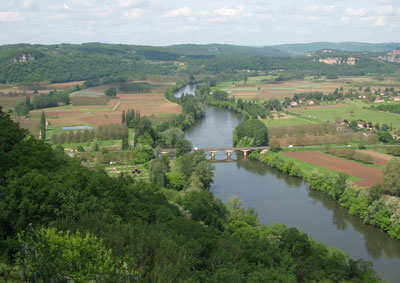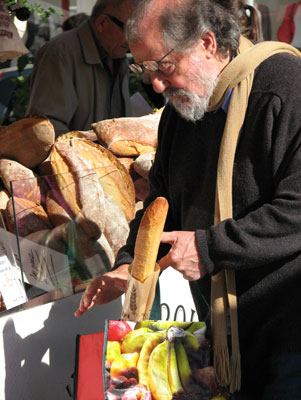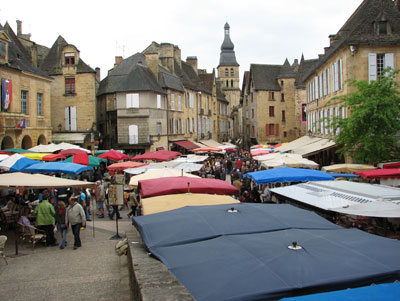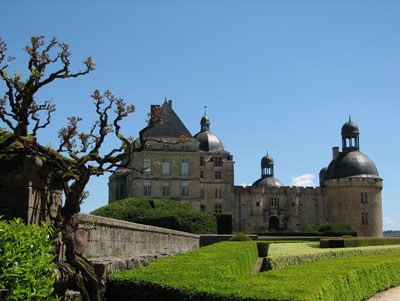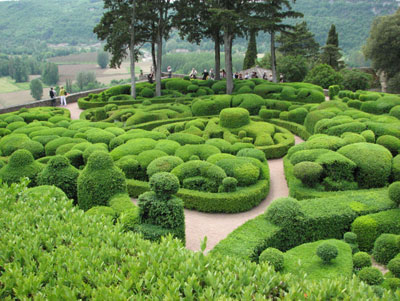France’s Dordogne
by Beth Habian, ITN
I must admit that, despite my profession, I’m a chicken when it comes to traveling to an unfamiliar place on my own. While many thrive on the excitement and challenge of tackling a foreign country independently, I like the security of traveling with someone who knows the destination and the language.
I don’t, however, enjoy being a “tourist.” The thought of walking through narrow streets following a guide holding a brightly colored plastic flower on a stick makes me cringe. For me, small-group travel is the way to go.
This year I was invited to join six other travelers on a 12-day May tour of France’s Dordogne region. The tour was led by George Nevin, founder of Intimate France, who has been guiding travelers through France for more than 15 years.
George’s quick sense of humor, laid-back style and proficient organizational skills helped make this a journey I will long remember. The green, rolling hills, flower-laden villages and elegant châteaux of this southwest section of the country didn’t hurt, either!
Getting there
My round-trip Northwest/KLM flight from Eugene, Oregon, to Bordeaux was booked several months in advance of my departure, but my near-perfect schedule was changed by the airline a few weeks after booking, resulting in a 7½-hour layover in Amsterdam.
Knowing I’d be too tired to stroll around the city for hours before making my connection, I decided to book a day room at Hotel Mercure Schiphol Terminal (phone +31206041339, fax +31206530438, www.accorhotels.com), located inside the airport just a short walk from my arrival gate.
Since I was going to have to stay awake to meet my group for dinner after arriving in Bordeaux, being able to get some sleep and freshen up with a shower made my small but clean room worth the €85 ($118), to me.
Be aware that the hotel is quite a distance from the departure gates and you must clear Passport Control on the way to your connecting flight, so give yourself a good half hour to get to your gate.
The Dordogne
Located in the Aquitaine region, the département of the Dordogne is named for the river that runs through it, though it is more often referred to by locals (and many guidebooks) as the Périgord, which this general area was once known as.
This small section of the country contains nine of the 151 Most Beautiful Villages of France, as designated by the association Les Plus Beaux Villages de France. Our itinerary included visits to five, including St. Jean de Cole, an incredibly picturesque village that, on the day of our visit, was festooned with vibrant floral garlands in preparation for their annual flower fair, Les Floralies.
Also featured on the itinerary, and what I found particularly appealing about this tour, was the chance to see the original prehistoric cave paintings at Font de Gaume and the replica cave art at Lascaux. I hadn’t expected much from the reconstructed cave, but, upon entering, I was impressed at the number and enormous sizes of the animals depicted there, especially after our excellent local guide, who had been inside the original cave on numerous occasions, told us that the real paintings were even brighter than the vivid reproductions.
While the Dordogne is overflowing with quaint villages and imposing châteaux, it seemed George had handpicked the absolute best spots, focusing his itinerary to expose us to a variety of sights without overwhelming us each day with long drives or creating a “Not another castle!” uproar.
Although, technically, I was working, George’s hard work behind the scenes allowed me to fully enjoy being “on vacation;” I just showed up each morning knowing that whatever unfolded would be a new, enchanting experience.
I will never forget such magical moments as sitting at an outdoor table amongst the remains of a ruined cloister in St. Émilion sipping sparkling wine and chatting with my newfound friends; enjoying a hilltop picnic featuring the delicious fare contributed by each group member, the assigned ingredients picked up that morning at the outdoor market in Sarlat; touring the rooms of Le Château des Milandes, the former home of jazz singer Josephine Baker, while recordings of her lilting voice floated through the air; cruising in the sunshine down the Dordogne in a replica of an 18th-century garbares, a traditional river craft of the area, to view the cliffside village of La Roque Gageac from the water, and standing at the spot, now little more than a rock overhang, where, in 1868, five Cro-Magnon skeletons were discovered.
The food
Also memorable on this trip was, of course, the food. We were in France, after all. With a few exceptions, each day of the tour featured one included group meal (besides the daily breakfast at each hotel), and the restaurants chosen all were wonderful. Each offered ample choice, and George was always at the ready to translate the menu.
Even for meals that were not on the itinerary, he would make restaurant suggestions and, early on, even made reservations for those interested in joining him for lunch or dinner. This made things much easier for travelers unfamiliar with French.
George would cover the total bill for the meal and would keep track of each person’s order, writing it down in his little book. At the end of the tour, a total for all such charges was presented to each guest, who could either pay before leaving for home or be billed upon arriving back in the US. I thought this was a very efficient system.
While the restaurants I enjoyed number too many to mention, there was one included meal that stood head and shoulders above the others. Our lunch at the Michelin-starred Le Moulin du Roc in Champagnac de Bélair was a featured item on our itinerary — so much so that when George discovered they would not be opening for the season as early as scheduled, he rearranged our entire program to keep this special experience on our agenda.
This restaurant/hotel, converted from a 17th-century mill house, was absolutely charming, situated along the Drônne River and surrounded by lovely gardens. Despite its notable reputation, it still felt comfortable and inviting, not stuffy or intimidating. (This was true of all of the restaurants at which we ate.)
Our lovely hostess, Maryse Gardillou, wife of chef Alain, presented us with a sweet little menu printed especially for our group, her tinkling laughter announcing her presence in the dining room.
Every bite of the 4-course lunch was an experience, from the creamy potage perfectly spiced with a hint of cardamom to the tangy, sweet-tart flavor of the passion fruit sorbet. Every element on every plate was paid careful attention, even the tiny caramelized tomato that accompanied my grilled cod fillet, which released an explosion of flavor when I bit into it. It was a perfect meal.
The accommodations
Also well chosen were the hotels on this trip. With only four hotels used for our entire 12-night stay, it was nice to be able to settle in and enjoy each area without having to pack and unpack every other day.
In Bordeaux, on our first and last nights of the tour, we stayed at the Novotel Bordeaux Aeroport, a modern hotel just minutes from the airport. Since Bordeaux was merely the starting and ending point of our tour, it was preferable to stay on the outskirts of the traffic-filled city, especially for those of us with early-morning departures.
In St. Émilion, the 3-star Hôtel Palais Cardinal was well located, allowing guests to walk to the center of this charming medieval town within minutes. The rooms here differed from one to the next. Mine was quite small, with a slanted ceiling above the shower, but, for me (only five feet tall), it was fine. George did check with each group member to make sure their accommodations were acceptable.
In the delightful town of Brantôme, I really enjoyed my room with its balcony doors that opened onto a view of the Drônne below. Some of the rooms at the 3-star Hôtel Chabrol have been wonderfully updated and others, like mine — still sporting a WC and bathroom with a ’70s color scheme — are on the list to be done. Still, the hotel is perfectly located (although pretty much everything is within walking distance in this small town) and its restaurant was fabulous.
Finally, we spent six nights in the heart of Sarlat at the Villa des Consuls, which offers both apartments and rooms. This was my favorite accommodation, perhaps because we stayed here for a good portion of the tour and it began to feel like home.
My comfortable room, equipped with a fridge and microwave, was airy and bright. There was also a laundry room with several washers and dryers for guests to use (costing €.50 for the detergent but otherwise free of charge) — perfect after a week of touring.
David, the owner, had some schooling in California, so his English was great, and he was most accommodating, offering help and suggestions whenever asked.
The people
In fact, everywhere we went in the Dordogne, the local people were friendly and enthusiastic. In St. Émilion, Monsieur Querre, proprietor of an interesting small ceramics museum there, spoke with such passion about his collection, his people and his country that his enthusiasm was infectious. I could have listened to him all day.
He also gave us a superb suggestion on where to have lunch, and the food at L’Huitrier-Pie (Il Rue de la porte Bouqueyre; phone 05 57 24 69 71) lived up to his fervent recommendation. (The “formula” menu, including two courses and a glass of wine, cost €18, or $25.)
Our guide for the tour of the Château Lynch-Bages winery, Kirsten, had a spectacular sense of humor and turned what could have been a quite dry explanation of the wine-making process into a truly enjoyable afternoon outing.
My only frustrating experience with the locals was trying to buy bread at the hugely crowded outdoor market in Sarlat. You really have to speak up to be noticed or you will be passed by for the regular customers (although, in fairness, they are the ones who will be coming back the next week). In contrast, shopping for a canelé pan in Brantôme’s tiny market was a pleasure.
Summing up
I had a fabulous time and would highly recommend a visit to the area, especially for lovers of wine and foie gras, which was featured on almost every menu.
Note: if you intend to bring home some of the foie gras for which the region is known, be sure to pack it in your checked luggage. I made the mistake of putting it in my carry-on bag, never once thinking it would be classified as “a liquid.” In the bin it went….
We enjoyed lovely weather, with only one day of rain at the end of the tour, and temperatures were mild. There is quite a bit of walking involved on this tour, so you should be in reasonably good shape if you want to take advantage of all of the scheduled activities.
I can wholeheartedly recommend a tour with Intimate France (Oakland, CA; 800/676-1247, www.IntimateFrance.com), and those who know me know I wouldn’t be so enthusiastic if I weren’t truly impressed. Group sizes are always small (never more than 20 people), and the itineraries are well planned and, if my experience is the norm, flawlessly executed.
The company offers only four escorted tours a year, including destinations in not only France but Italy (and, on occasion, Croatia). Tours change yearly to keep things new and exciting for Intimate France’s many repeat travelers, but the Dordogne tour will be offered again in 2010 (Sept. 26-Oct. 8), with some variation in accommodations. Custom tours can be arranged on request.
The land-only cost for next year’s tour is $3,795 per person, based on double occupancy; the single supplement is $450. With the exception of some meals and drinks, international airfare and, of course, personal expenditures, everything is included in the tour price.
Beth Habian was the guest of Intimate France.


